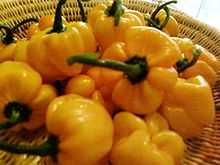Ají dulce


Ají dulce (from South American Spanish ají, "chili" + Spanish dulce, "sweet") is any of a variety of sweet perennial peppers found in Latin America and the Caribbean. It is most widely known in Venezuela where it refers to a specific native variety of Capsicum chinense related to the habanero, but with a much milder, smoky flavour.
In Venezuela, the "ají dulce" is a key ingredient in the preparation of the paramount dish of the Venezuelan cuisine, the Hallaca; and one of the cornerstones of the national cuisine.
In Puerto Rico, the "ají dulce" or "ajicito" (colloquially, "ajice") is grown commercially and is an important ingredient for sauces, such as recaíto, sofrito or "mojito isleño" (a fish or meat sauce).
In Brazil, this pepper is called Rubra or Biquinho (Because the rounded-form cultivar; observe the first photo), and is used to make a sweet jam.
The history of this pepper is obscure, but since wild peppers are naturally hot this variety was probably developed over the years among farmers by simple selection of seed from milder and milder fruits. The fruit of aji dulce can be used green or ripe, and it can be seeded and frozen for use over the winter, a technique that also preserves its rich flavor much better than drying. It is a small, light green pepper that turns red (or yellow) if left long enough on the plant. It has the shape and size of a habanero pepper without the intense heat. Occasionally, there can be some ají dulce fruit that is pungent, probably due to out-crossing with other hot pepper plants. In the tropics, this plant can grow as a perennial, although most of the commercial production is with annual systems.


See also
- Ají pepper, a spicier pepper
- List of Capsicum cultivars
References
- Weaver, William Woys. (2000) 100 Vegetables and Where They Came From. Chapel Hill, NC: Algonquin Books. ISBN 1-56512-238-0
| ||||||||||||||||||||||||||